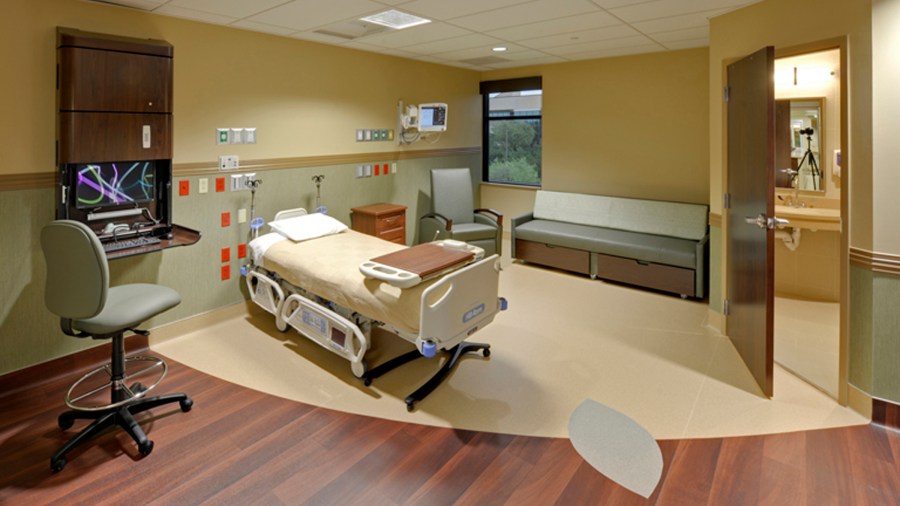The tech that can help crank out more critical care hospital space

States and cities are rushing to find hospital beds to prepare for an increase in patients suffering from COVID-19. In New York, makeshift hospitals are going up in Central Park and a Navy hospital ship is in the city’s harbor. Its Javits Convention Center has been converted into a temporary medical facility, and the U.S. Army Corps of Engineers is looking to convert empty hotels and other buildings into hospitals across the country.
As part of its response to the coronavirus, the Chinese government built two giant hospitals in 10 days, and I wondered if we could build hospitals that fast here in the U.S., and what tech exists to innovate in the construction process. I spoke with Chris Giattina, someone who is working on it. He’s the CEO of the manufacturing and design firm Blox, which specializes in modular medical facility construction. The following is an edited transcript of our conversation.

Chris Giattina: We deliver acute care facilities — think about hospitals — and we design them digitally and we manufacture them in our plant. Imagine a big complex Lego that we can ship out, and when we get there, we assemble it as a completed building. All of this relies on a bunch of technology that we use: the digital design, the supply chain and the machines that make these parts real together. At the end, we take raw material and we turn it into hospitals.
Molly Wood: About how long does that take?
Giattina: [A] typical building may take 12 to 16 months to make. We do it in four months now, and every day we have a team that’s working to make it faster and faster.
Wood: I asked that because — no pressure — but it seems as though we are going to need some health care facilities quickly. How do you see your company being a part of that?
Giattina: A few weeks ago, when the size of this pandemic became clear, our team had to refocus. We were making permanent hospitals, and we were doing them really fast, but we had to think about how to take this problem and put it through our machine, Blox, and figure out how to do that so that we could get hospital beds quicker. A MICU is a mobile isolation care unit. This MICU has three jobs. The first one is, it’s got to protect the front-line health care workers. Then, there’s the second thing that they’ve got to do, which is they’re designed to protect the hospital’s existing capacity. The final one is we’re trying to make these MICUs become a permanent and flexible asset that helps serve the health system going forward. They’re institutional grade, they’re reusable. It’s a fleet of ICU rooms that gets to be moved in the future to wherever the hot spot is.
Wood: How much do they cost?
Giattina: These things will be around $200,000 to $300,000 a bed in the beginning, and then those prices will drop down. These are significantly less expensive, but they’re still high-tech devices that are chock full of equipment and pressurization and electronics, and they’re still pretty expensive boxes.
Wood: Can you tell us at all where these projects might be happening, like where you’re putting up these MICUs?
Giattina: We’re not putting them up yet. It’s still going to production in two weeks. The first ones could be in any of the spots that are needed. Obviously, we’ve been in pretty heavy discussions in New York, we’ve been in discussions in Georgia, and there’s a big delta between those two places, but it really doesn’t matter to us where they’re needed. They can go just as easily to one or the other.
Wood: Just out of curiosity, is it like a modular house, where it’s basically pre-built and then it just comes on a big truck?
Giattina: Parts of it are. A Lego analogy is really a pretty good one. If you think about a Lego kit, or [an] advanced one, it has different types of parts. Some of them are volumetric, and some of them are custom parts, and some of them are little pieces that can be used in 1,000 different ways. We’re agnostic about it. We think that there’s just a value stream that goes from raw material and it’s converted into a usable building. And the process that it goes through is a whole lot of different stages. We’re just trying to find an optimal one. There’s not always a right path, because in fact, we’re using many of the things that we do for regular hospitals right now, but we’ve made different changes. The foundation, for example, is significantly different on a MICU — it doesn’t need all of the permanence that an acute care hospital may have that has a 50-year lifespan. The idea is, we think of it as completed parts, but every part is completed and it goes together in a form of chunking. It’s kind of the way they build a new Boeing 787 Dreamliner — it’s not made on an assembly line the way you think of an assembly line. It’s made in chunks that are made all over the world, and they’re all brought together to Charleston and put together as an [original equipment manufacturer] in a matter of days. That’s more like what we’re doing with Blox.
Wood: Got it. What makes these specific to medical facilities? What kind of certification and technology goes into that?
Giattina: The hospitals are really heavily regulated. If you try and understand which ones there are, it’s a long list. What I would just simply say is these things are dealing with life safety at an institutional level. They’re dealing with emergency power, critical care operations. They’re dealing with temperature control that’s based on air exchanges, which allow you to evacuate disease and infection. They are designed to be visible and operational, high performance, if you will. These nurses and doctors are under enormous pressure, and what you’re trying to do is create a place which is safe for them to work but visually controlled so they can see everything at once. That’s what we focused on: How do we make this really a beautiful, elegantly simple, operationally, visually controlled device that is technologically empowered, and can be deployed really fast, and still be done with the stuff that’s available today, not the stuff that we wish was available today?
Wood: You said that you’re trying to take a typical construction time for a building from 12 to 18 months down to four months. How long will it take to construct these MICUs?
Giattina: The first one will roll off in June (the end of May), and it’ll be operational a week later. After that, they’ll just keep coming as long as they’re needed. Once the line is loaded, then think of it as just a continuous river that keeps dropping them out. There’s about 10 large modules in each one of these, and every day and a half, another 10 will be ready to be shipped.
Wood: It’s clearly a technological miracle in a lot of ways. June is a long ways away. Do you wish that you had started getting called sooner?
Giattina: Yes. Necessity is the mother of invention, and I think that we’re, as a nation, in the midst of a necessity. I like what I see in terms of the human spirit coming together to try and solve hard problems right now.
Related links: More insight from Molly Wood
To the point about whether Blox is already building facilities, Fast Company has a piece on how we have the technology and modular construction expertise to get buildings up quickly. But we also have lots of logistics and red-tape problems. The Army Corps of Engineers, as you heard, wants to convert existing facilities, but for the reasons that Giattina mentioned, a hotel or convention center is not ideal for the job because they’re hard to sterilize. They need HVAC systems that can prevent infectious diseases from being pumped into every room and other needs. The piece points to some modular design companies that are creating medical pods that can be built quickly. But since each city and state has its own rules around construction permits, and even just a shortage of land to put modules on, it’s a tough problem to solve quickly at a time when speed is what we need.
Also watching
The Wall Street Journal reports that the U.S. is already starting to track people’s smartphone data to analyze people’s movements to ultimately build a database that can show, at a national level, how well social distancing measures are working and where people might be gathering together in large groups so that authorities can both crack down and potentially predict a future outbreak. I’m going to have more conversations about this later in the week: The need for a data-driven response to this outbreak and the fact that this is useful data.
It is also likely to become a privacy invasion at a grand scale. TechCrunch has a piece about how Singapore is collecting data in a more privacy friendly way through an app called TraceTogether. That’s what the Massachusetts Institute of Technology is trying to do with its app, Safe Paths, but both cases rely on people downloading the app, using it and voluntarily reporting information. In Singapore, there’s a more central authority that can make people do the thing. That’s a lot harder in the U.S., and since the data already exists in one giant cookie jar full of delicious quarantine baked cookies, it’s going to be hard to convince the cookie monster to find another treat.
The future of this podcast starts with you.
Every day, the “Marketplace Tech” team demystifies the digital economy with stories that explore more than just Big Tech. We’re committed to covering topics that matter to you and the world around us, diving deep into how technology intersects with climate change, inequity, and disinformation.
As part of a nonprofit newsroom, we’re counting on listeners like you to keep this public service paywall-free and available to all.
Support “Marketplace Tech” in any amount today and become a partner in our mission.





















